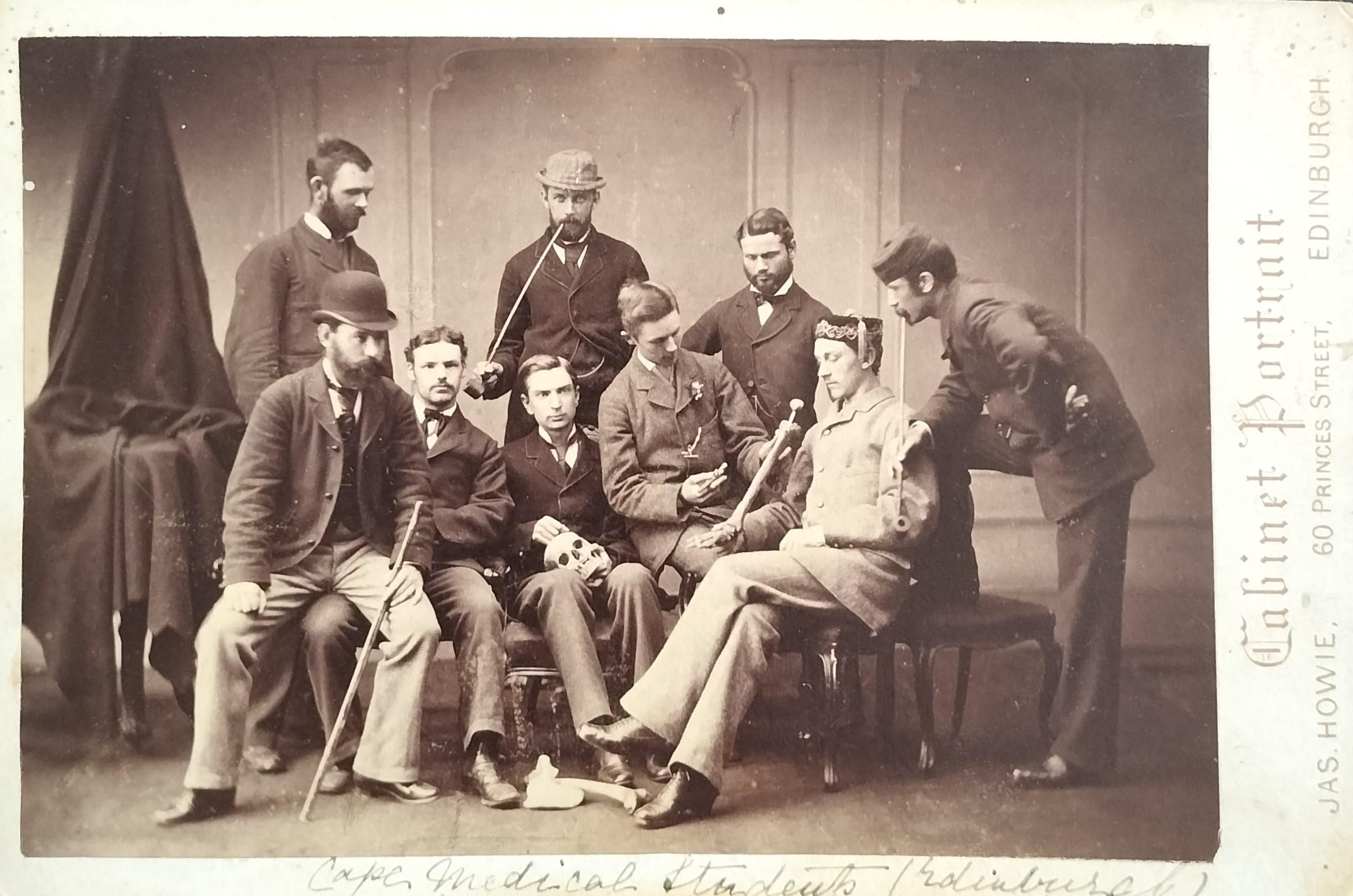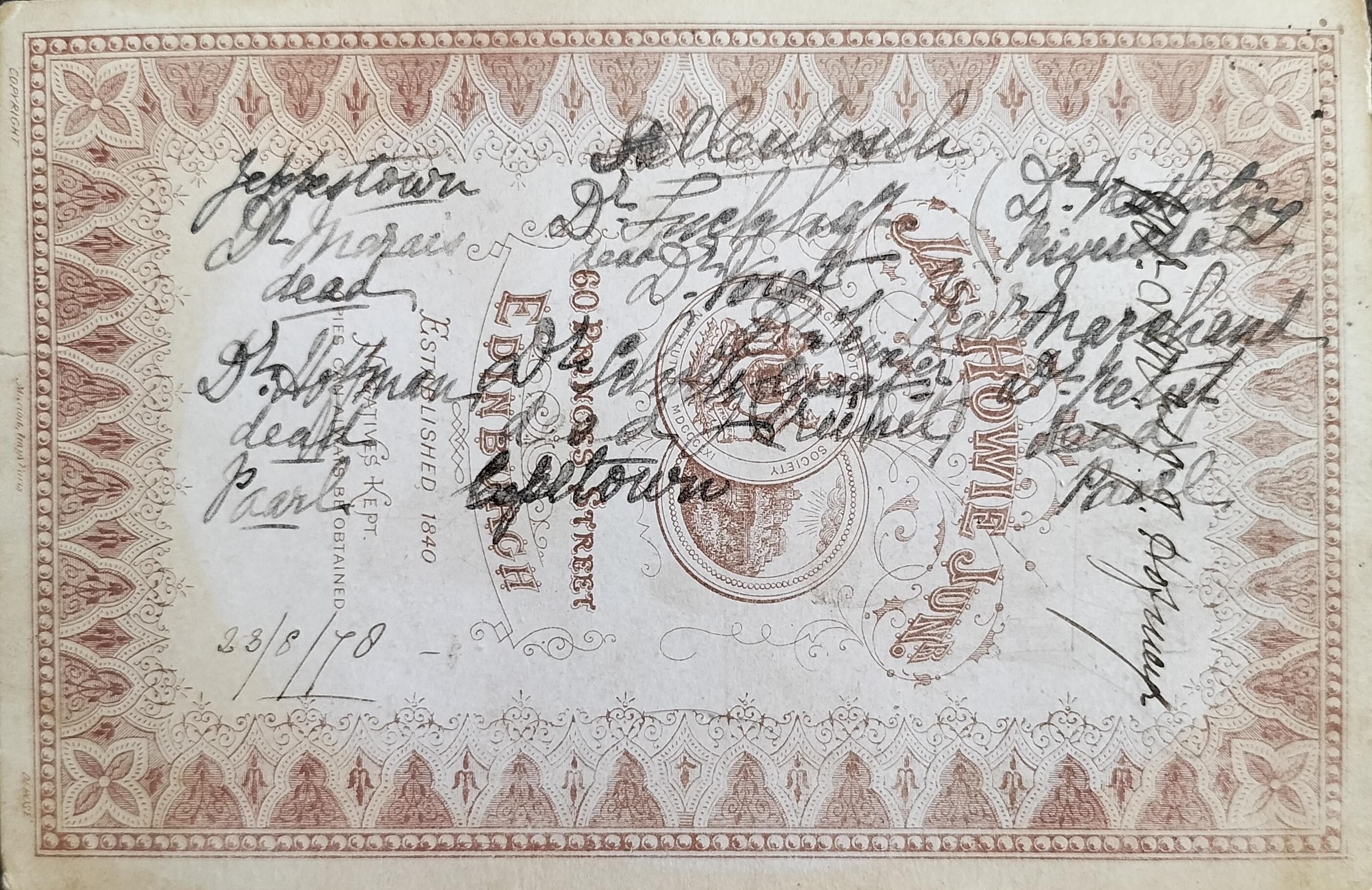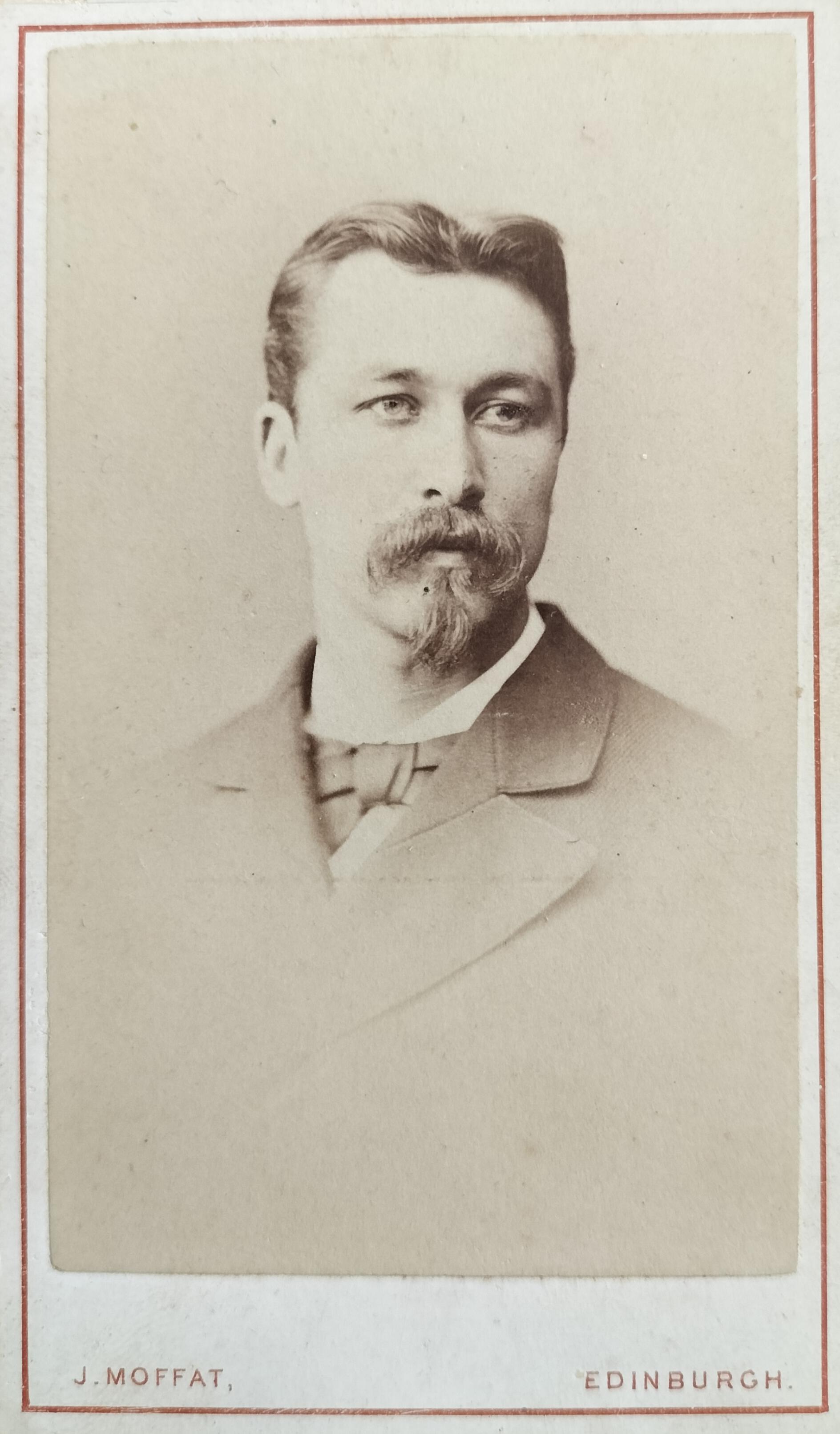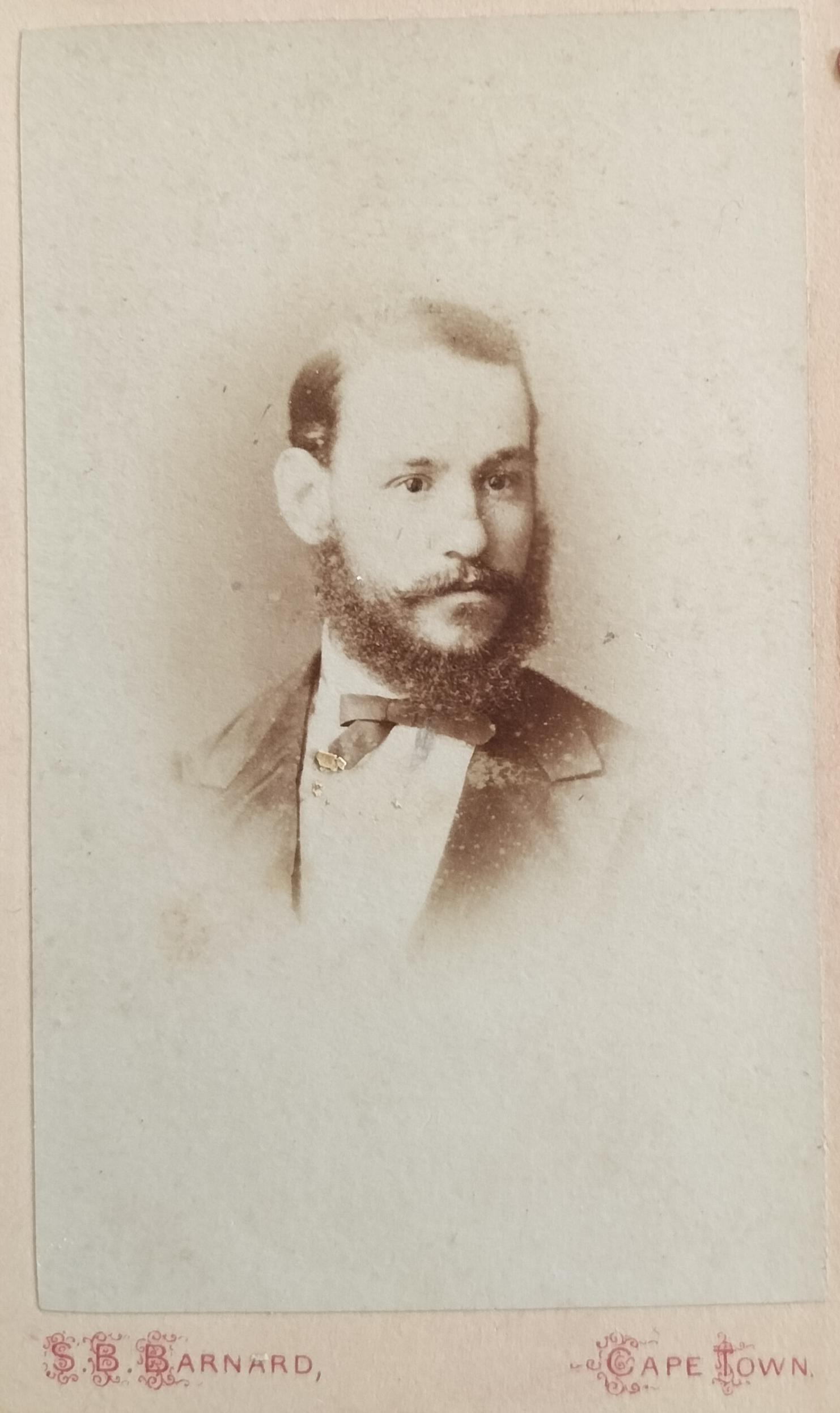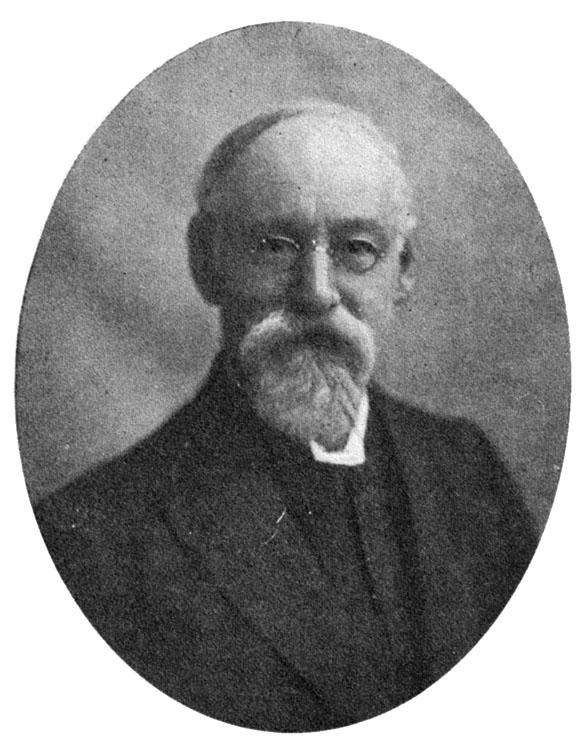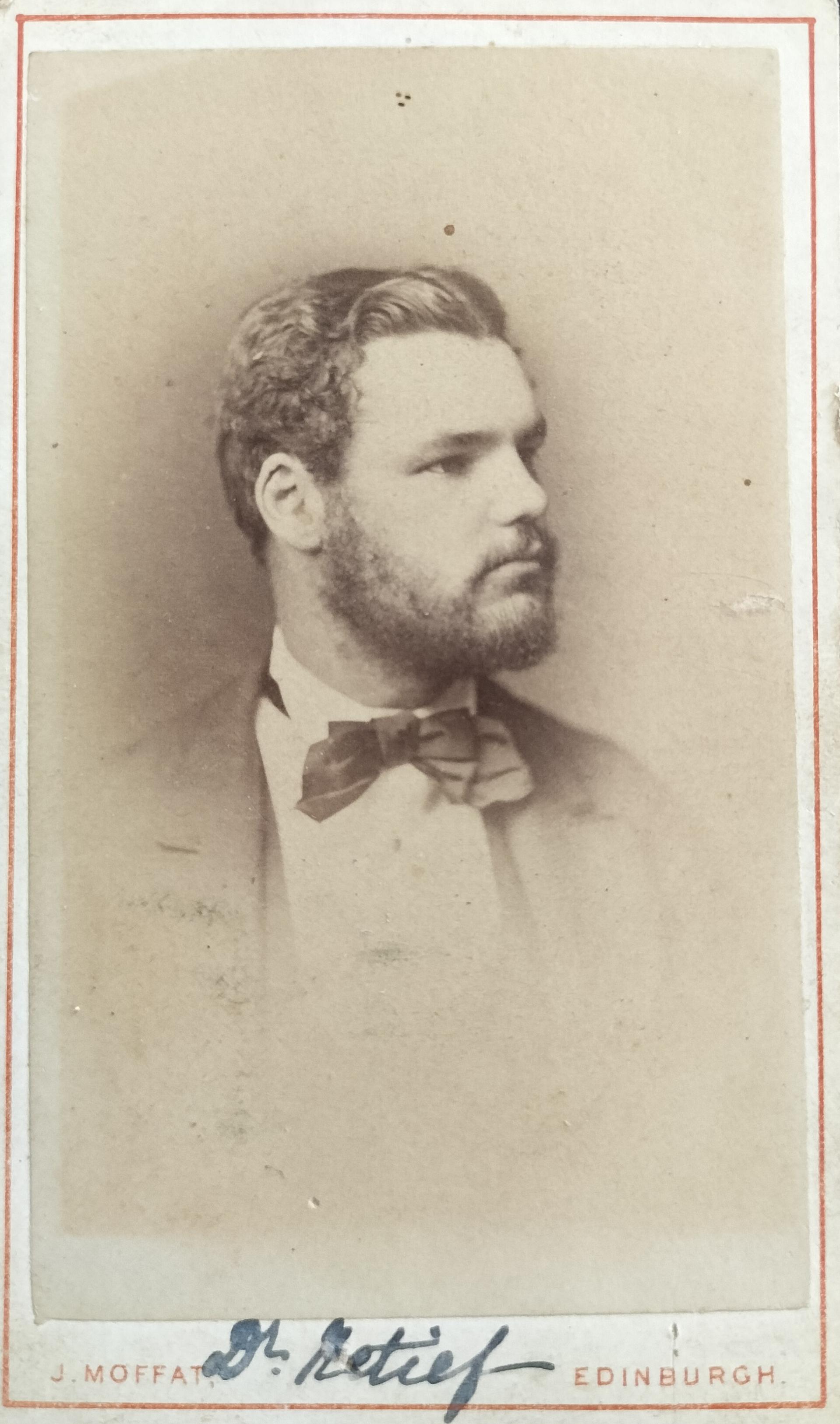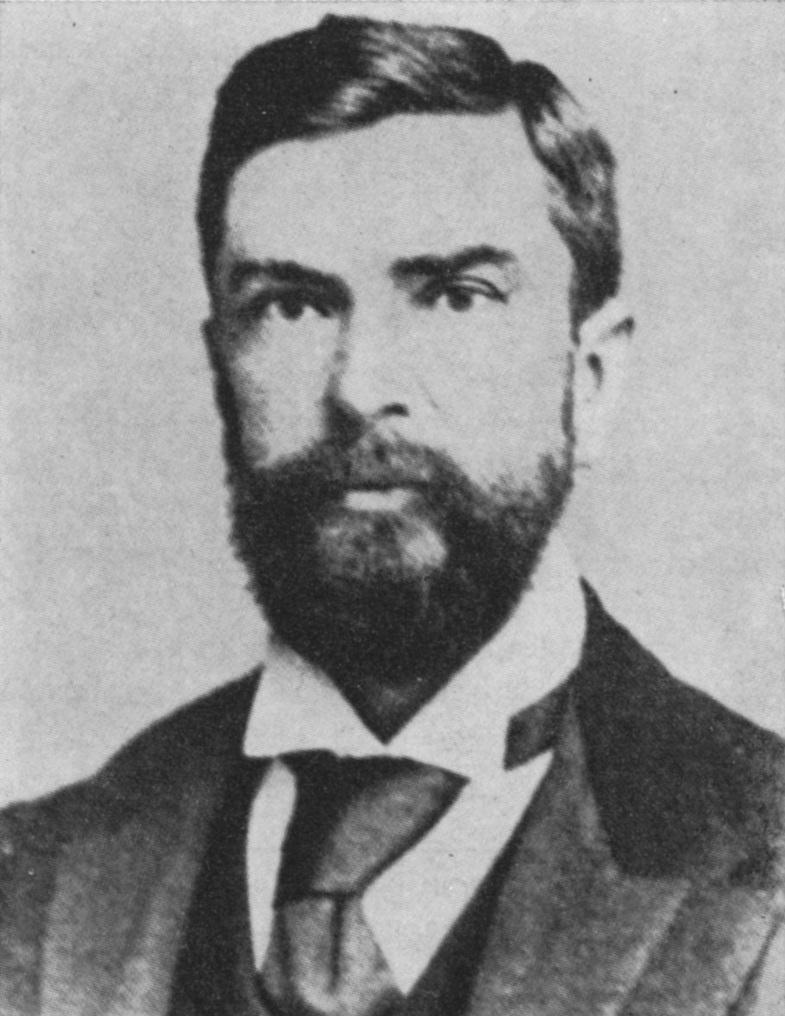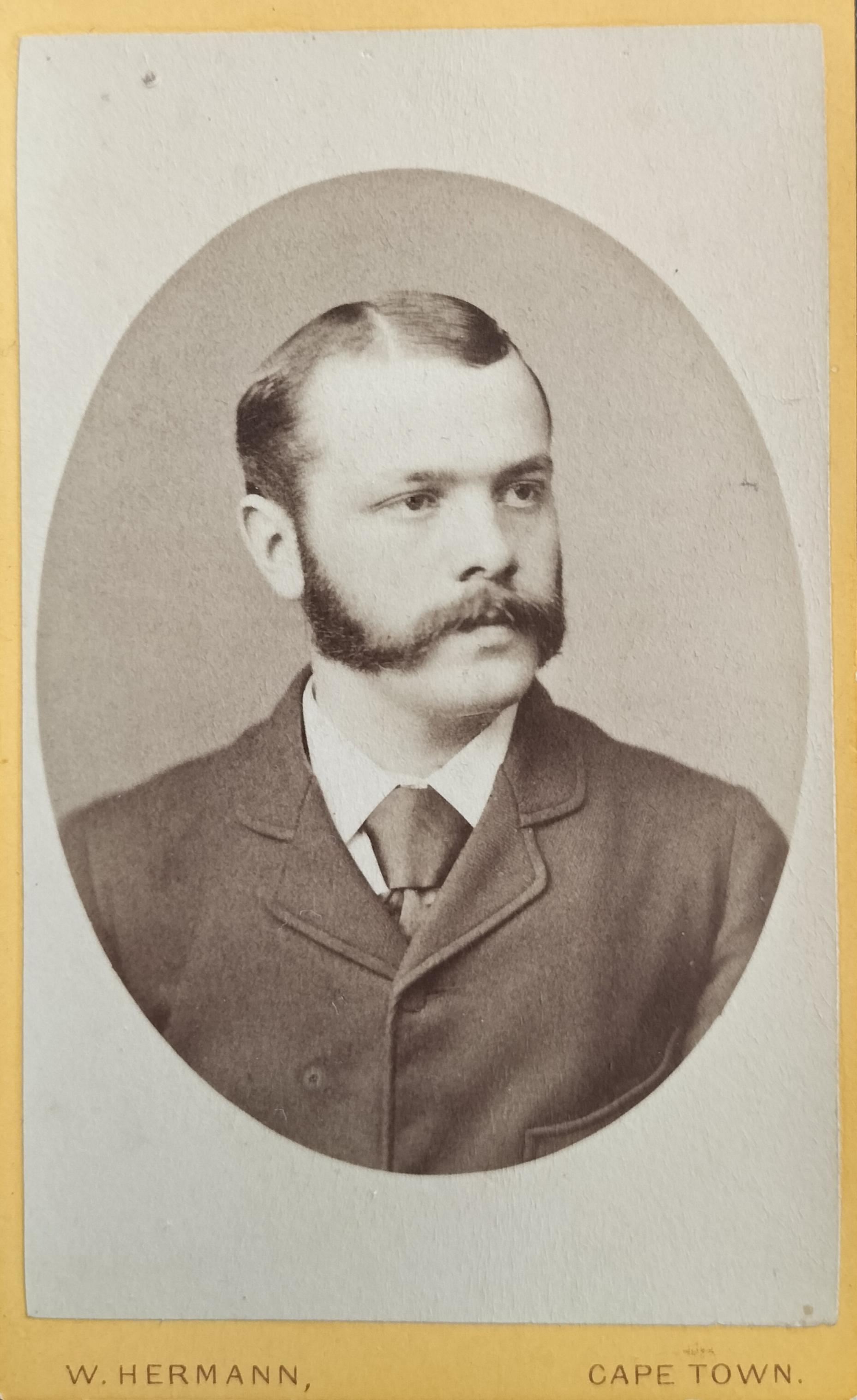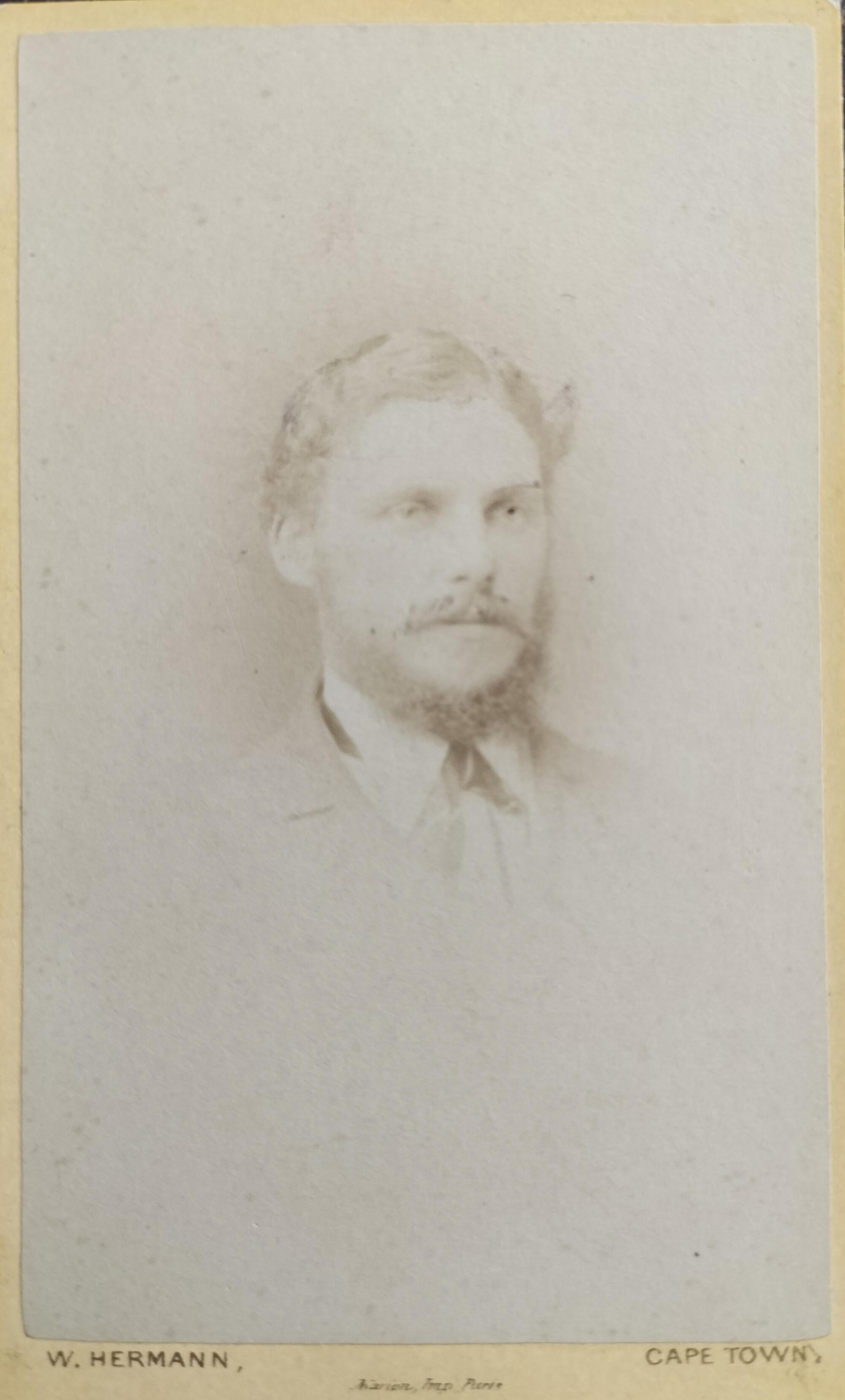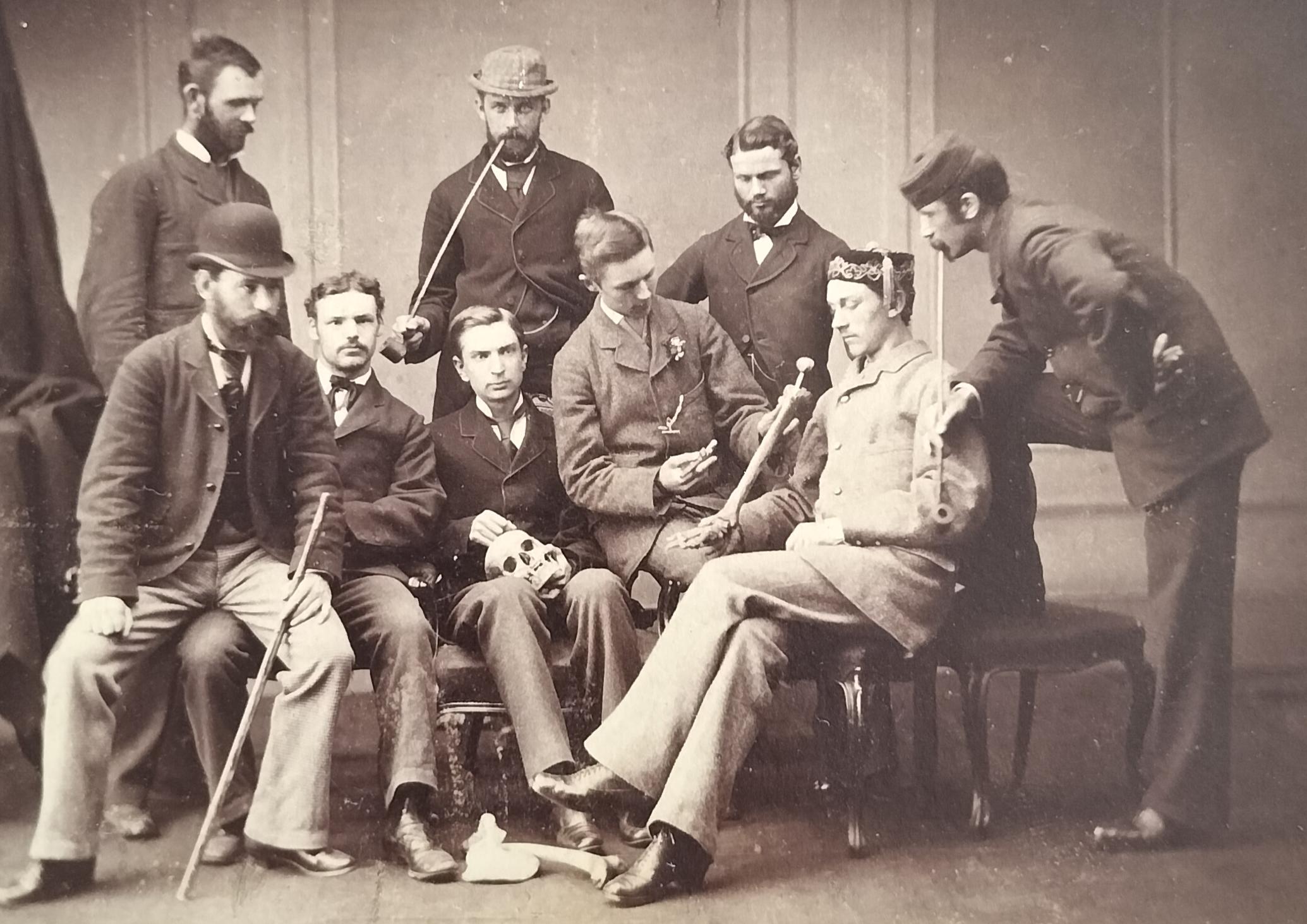
Disclaimer: Any views expressed by individuals and organisations are their own and do not in any way represent the views of The Heritage Portal. If you find any mistakes or historical inaccuracies, please contact the editor.
A Victorian photograph album can be described as an artefact, but so can the content. Each photograph included in these albums of old is therefore also an artefact in its own right. Where provenance, such as details of the photographer and/or sitter, is provided on a photograph, the value of the photographic artefact becomes even more significant.
A recent Victorian album acquired by the Hardijzer Photographic Research Collection (HPRC) contained a single cabinet card format photograph which immediately grabbed my attention. It is a rather playful image showing nine men, eight of which are medical students who underwent their training in Edinburgh between 1875 and 1883. The photograph, with a hand written inscription: “Cape Medical Students/Edinburgh”, was captured on 23 August 1878 by the Scottish photographer Jas. Howie Junior.
Also included in the album were some smaller Carte-de-Visite format photographs of the same individuals that appear on the Cabinet Card. In addition, the album also contained another two medical students who do not appear on the Cabinet Card image.
What makes the Cabinet Card unique is that each sitter’s name has been recorded on the back of the card. Without this provenance, this card would just have become another image of interest, but of little value as an artefact.
This creatively posed image is further of interest in that the medical students are seemingly studying a human skeleton (bones and skeleton). Two of the sitters are holding long pipes. These pipes are known as churchwardens or reading pipes (in German).
This article mainly focuses on the single cabinet card and attempts to optimally unravel the biographical information of each of the medical practitioners that appear in the photograph.
The album, containing more than a 100 photographs, used to belong to Mrs DP le Roux. More about her later.
South African medical students abroad
It was only from 1922 onwards that the Cape had its first locally trained medical graduates, resulting in South African citizens, before this period, going abroad to receive their training as medical practitioners. European countries of choice included the Netherlands, Germany & Scotland.
Leiden remained the popular school for South African students until the middle of the 19th century, whereafter most students from the Cape went to a Scottish university, resulting in Edinburgh becoming the university of choice by 1880.
Although the University of Edinburgh's Faculty of Medicine was not formally organised until 1726, medicine had been taught at Edinburgh since the beginning of the sixteenth century.
Three medical degrees were conferred at Edinburgh, namely: Bachelor of Medicine, Master in Surgery, and Doctor of Medicine. Before December 1881, the Degree of Bachelor of Medicine (M.B.) could be taken alone, but the Degree of Master in Surgery (C.M.) could not be conferred on any person who had not completed an M.B. From December 1881 both Degrees (M.B. and C.M.) had to be taken at the same time. The study duration for the combined Degrees of Bachelor of Medicine and Master in Surgery extended over four years.
At the turn of the century, the medical fraternity in Cape Town totalled about 150 practitioners and included some outstanding men who became acutely conscious of the need for a medical faculty in South Africa, and who made urgent representations to the South African College. In 1890 the Council of the College approached Edinburgh with the humble petition that it should recognize the South African College for scientific and laboratory work for medical purposes. This initial petition was unsuccessful, but ten years later, pleas for the establishment of a medical faculty were made by members of the Medical Association of South Africa, enthusiastically led by Dr E. Barnard Fuller (Louw, 1979).
A) Nine Men on a Cabinet Card Photograph
Of the nine men on the photograph, eight studied medicine. The ninth individual studied theology in Scotland and most likely agreed with his friends from back home to be present at the studio on the day the photograph was captured.
At least four of the men achieved much success in their careers, while others died young. Five of the nine men did not make it beyond the age of 55. Only one of the nine reached the age of 80.
One of the eight students remained in England (Lancashire) following the completion of his studies where he practised as a medical practitioner.
Five of the eight continued their medical studies at Edinburgh to obtain a qualification as a Doctor in Medicine (MD).
It is recorded that two of the men served in a medical capacity during the Anglo-Boer War, one on either side of the two warring factions.
Whilst the camaraderie amongst the men in this creatively posed photograph is obvious, each of them followed their own distinct careers post their student years. There seems to have been little, if any, contact with each other post their return to South Africa.
Here are their individual stories.
Cabinet format photograph of nine South Africans, captured by Edinburgh-based photographer, Jas Howie. Seated from left to right are: Reverand Marchant, Dr. Retief, Dr. Scholtz (with skull on his lap), Dr Te Water and Dr. Hoffman. Standing from left to right are Dr. Neethling, Dr. Lückhoff (with long pipe), Dr. Voigt and Dr. Marais (with long pipe and foot on chair).
Back of the above Cabinet Card containing the names of each sitter
1) Hoffman - Josias Matthias (1851 – 1904)
Hoffman obtained his Bachelor in Medicine and Master’s in Surgery (MB CM) at Edinburgh University in 1881.
Hoffman was born in Stellenbosch on 8 November 1851 and passed away at the age of 52 on 21 October 1904 in Paarl. He was the son to Eduard Bernard and Elizabeth Getruida Frederika Neethling.
He married Anna Catherina Margaretha van Velden on 20 January 1882 in Paarl. Anna passed away in Paarl on 3 November 1890, aged 40. She left 5 children aged between a few days and 7 years old.
On 1 January 1903 Hoffman married Sophie Julie van Velden in Paarl. Sophie was the older sister of Anna. Sophie passed away on 16 December 1944 at the age of 91.
Carte-de-Visite photograph by Edinburgh-based photographer Moffat of Doctor Josias Matthias Hoffman (1851 - 1904)
2) Lückhoff - Gerhard Wilhelm Conrad (1852 - 1881)
Lückhoff obtained his Bachelor in Medicine and Master’s in Surgery (MB CM) at Edinburgh University in 1880.
Born in Stellenbosch, he was the son of Paul Daniel and Johanna Susanna Albertyn.
Lückhoff hardly had the opportunity to practise in the field of medicine in that not long after his return from Edinburgh he passed away in Stellenbosch at the age of 29 on 14 June 1881. He was unmarried at the time of his death.
Carte-de-Visite photograph by Edinburgh-based photographer Moffat of Doctor Gerhard Wilhelm Conrad Lückhoff (1852 - 1881)
3) Marchand - Reverend Bernard Petrus Jacobus (1853 – 1917)
Marchand was born on 22 August 1853 in Wellington.
His parents were Bernard Petrus Jacobus Marchand and Susanna Margaretha le Roux.
Marchand is an exception on the photograph. Why would he have joined the remainder of the group of medical students?
The first thought may be that he was in Edinburgh to attend to their spiritual needs. Given that he was of similar age compared to the rest of the group, it is safe to assume that they were friends and that he visited them on the day the photograph was taken. This link is further confirmed by him obtaining his training as a Reverand in Scotland at the theological college of the Free Church.
Aged 29, he married a Scottish lass, Annabella Wilson Lochardt on 15 September 1882. The couple had two children.
Marchant is credited with the establishment of the Kakamas labour colony, an irrigation scheme intended to assist the poor white.
He is also credited with establishing two illustrious schools, namely Hoër Seunskool in Rondebosch and the Hoër Meisieskool in Rustenburg.
Marchand died at the age of 64 in Rondebosch on 5 October 1917, only two months after the church complex on Marchand (named after him) was inaugurated on 25 August 1917.
Carte-de-Visite photograph by Cape-Town-based photographer Barnard of Reverand Bernard Petrus Jacobus Marchant (1853 - 1917)
Reverand Merchant (1853 – 1917) – extracted from Wikipedia
4) Marias - Francois Paulus (1855 – 1904)
Marais obtained his Bachelor in Medicine and Master’s in Surgery (MB CM) at Edinburgh University in 1882 and Doctor in Medicine (MD) qualification in 1888. His thesis was titled: Discussion on the nature & cause of an epidemic of fever at Wellington, South Africa, in the autumn of 1887.
Born in Wellington in the Cape Colony in May 1855, he passed away in Fordsburg (Johannesburg) on 17 March 1904 at the age of 48. His parents were Francois Paulus Marais and Johanna Getruida Retief.
He must have practised in several towns before settling in Fordsburg in that the couple’s first child was born in Colesberg in December 1885, with their second child that was born in Bredasdorp in 1889 and their third child in Ladismith in 1892.
Marais married Scottish-born Jane Wright Gillison on 14 January 1884 in Cape Town. Jane passed away 4 days after her husband (21 March 1904), leaving 4 children between the ages of 12 and 18.
5) Neethling - Andrew Murray (1855 – 1922)
Neethling obtained his Bachelor in Medicine and Master’s in Surgery (MB CM) at Edinburgh University in 1883. It has been recorded that he also completed his MD degree. No record of this was found in the Edinburgh University records.
Born on 1 April 1855 in Prince Albert, he was the son of Johannes Hendrik and Maria Murray.
Neethling married Annie Fleming Paterson in Stellenbosch on 18 June 1887. The couple had three children (1 daughter and 2 sons). One record suggests that the couple may have had four children.
On his return from Scotland, Neethling mainly practised in Barberton and Lydenburg before the start of the Anglo-Boer War (1899). He was the Chief Medical Officer serving under General Joubert and served amongst others at Dundee, Elandslaagte, Ladysmith, Sand River and Pilgrimsrest.
After the war, he was part of the Cape Colony Parliament as a member for Beaufort West.
In 1914 he served under General Botha with the rank of colonel in the German South West Africa campaign. His two sons served with him in the campaign, one of which was killed near Kakamas. Following the campaign, Neethling became the chief medical officer of the conquered territory. For his service in the military, Neethling was awarded various medals, amongst them the DTD (Dekoratie voor Trouwe Dienst – Decoration for Loyal Service).
Neethling passed away in Pretoria at the age of 67 on 6 July 1922.
Neethling’s younger brother, Johannes Henoch Neethling, also graduated from Edinburgh in 1885 (MB CM).
6) Retief - Petrus Jacobus (1854 – 1906)
Retief obtained his Bachelor in Medicine and Master’s in Surgery (MB CM) at Edinburgh University in 1880 and Doctor in Medicine (MD) qualification in 1883. His dissertation was on: 'Observation on the action of copaiva balsam and the changes it undergoes in its passage through the system'.
Born in Paarl in 1854, he passed away in Paarl at the age of 52 on 22 September 1906.
At the age of 42, Retief married Getruida Margaretha Malherbe on 20 October 1896 in Paarl.
At the time of his death, his wife was 8 months pregnant with their fifth child. The other children were between the ages 2 and 8. He passed away following throat cancer.
Carte-de-Visite photograph by Edinburgh-based photographer Moffat of Doctor Petrus Jacobus Retief (1854 - 1906)
7) Scholtz - William Christian (1858 – 1902)
Scholtz obtained his Bachelor in Medicine and Master’s in Surgery (MB CM) at Edinburgh University in 1881 and Doctor in Medicine (MD) qualification in 1884. His dissertation was titled: General notes of cases in private practice, with observations.
Son to Carel Frederik Scholtz and Justina Petronella Francina Vos, he was born on 11 December 1858 in Oudtshoorn. Scholtz died at the age of 42 in Cape Town on 7 March 1902.
Scholtz initially practised in Paarl for 10 months whereafter he settled in Cape Town as a general practitioner between 1886 and 1899. During this period he was a consulting surgeon at the Woodstock Hospital and a vaccination officer for the Woodstock municipality. In later years he specialised in diseases of the ear, nose and throat. In 1891 he was elected an inaugural member of the Colonial Medical Council and remained a member until at least 1896. In 1897 he attended the International Medical Conference in Moscow as the sole South African representative. At that time he was a director of the South African Industrial Life Assurance Society.
Scholtz published papers on "The influenza epidemic at the Cape" (British Medical Journal, 1890), "Medical charges and payments" (South African Medical Journal [Series II], 1895), and "Laryngology and otology" (Transactions of the South African Medical Congress, 1894).
Scholtz, however, was mainly an authority on the South African climate and its relation to health - a popular topic at the time. Scholtz's interest led to the publication of a book in 1897 with the descriptive title: The South African climate; including climatology and balneology and discussing the advantages, peculiarities and capabilities of the country as a health resort - more particularly with reference to affections of the chest.
In January 1900, during the Anglo-Boer War (1899-1902), Scholtz acted as an envoy of Lord Roberts in negotiations with General Louis Botha near Kimberley. After Roberts had occupied Bloemfontein on 13 March 1900 Scholtz joined the British forces there in a medical capacity. He died two years later.
Interesting about the above narrative is that Scholtz stood on the opposite side of one of his fellow students at Edinburgh during the war, namely Andrew Murray Neethling, who served on the Boer side during the war.
Scholtz was married to Agnes Judith Ellis. He left 3 minor children at the time of his death.
8) Te Water - Thomas Nicholas Germain (1857 – 1926)
Te Water obtained his Bachelor in Medicine and Master in Surgery (MB CM) at Edinburgh University in 1879 and Doctor in Medicine (MD) qualification in 1882. Te Water completed two years of post-graduate work in Berlin, Vienna, Strasbourg and London before obtaining his MD qualification. His dissertation was titled: Apocynin: a cardiac poison in radix in apocyni cannabin.
Te Water was a member of a well-known Graaff-Reinet family and hence possessed useful contacts with which to forge a career resulting in Te Water spending much of his life in Graaff-Reinet following his qualification as a doctor and also benefited from his post-graduate training in Europe.
Set up in Graaff-Reinet in 1881, Te Water's practice was shaped to a large extent by its Cape context—notably by a crowded medical market, a mix of public and private practice, the wide geographical extent of a rural practice, and by a segregated society's racial divisions that helped shape his patient constituency.
Te Water took his duties as district surgeon seriously, adopting an interventionist stance, as did most contemporary medical colleagues at the time.
Very unusually for a South African doctor, some of his clinical case books, together with financial accounts and correspondence with patients have survived which enabled a partial reconstruction of his medical practice and its relationship to his political activities.
Following his successful general practice in Graaff-Reinet, he moved to Cape Town to participate in politics where he assumed a position at the leading edge of modernization in the Cape Colony.
During his career Te Water placed emphasis on reforms in public health in the Cape Colony's Colonial Department that shaped his interventionism first as a local district surgeon and later as Colonial Secretary.
Te Water's move into political activity was a logical career progression. He was encouraged to go into politics by his lifelong friend, JH Hofmeyr, who continued to act as his political mentor. Hofmeyr was the uncrowned leader of the Afrikaner Bond which, by the 1890s, was the most powerful political group in the House of Assembly.
As a local politician, Te Water had aimed to defuse the ethnic tensions in the white community that had become so evident in municipal and divisional elections before his election in 1893. The inhabitants of Graaff-Reinet and its surrounding district were conspicuously split between Dutch (later termed Afrikaner or Boer) agriculturists and wealthier English businesspeople.
A political asset was that although Te Water's home language was English, with his wife, Minnie (née Currie), being of British settler stock, his political sympathies remained towards the Dutch.
Te Water achieved Cape ministerial office in two short-lived ministries, first as Colonial Secretary in Sir Gordon Sprigg's cabinet from July 1896 to May 1898, and then as Minister without Portfolio in WP Schreiner's ministry from 1898 to 1900.
A few months after the end of the war (May 1902), Te Water retired from political and public life following a stroke from which he never fully recovered. However, a decade later (1912), he was persuaded to become a member of the TB Commission within the Union of the Cape with the three other colonies.
The Edinburgh University records also show a Carel T Te Water who completed his medical qualification (MB CM) at the institution in 1888.
Doctor Thomas Nicolas Germain Te Water (1857 - 1926) - extracted from Wikipedia
9) Voigt - Johan Carel (1854 - 1940)
Voigt obtained his Bachelor in Medicine and Master’s in Surgery (MB CM) at Edinburgh University in 1882 and Doctor in Medicine (MD) qualification in 1885. His dissertation was titled: Record of antiseptic work with eucalyptus oil and corrosive sublimate: Cases from the surgical practice of the infirmary, Bury (Lancashire).
Born to Abraham Johannes Voight and Georgina Wilhelmina Thorn in Paarl in November 1854.
He married British-born Emmiline Dearden in 1890. Records also suggest that he did not practise in South Africa as a medical practitioner. Censuses for 1901 & 1911 confirm that the family of 5 was based in Lancashire. The couple’s first child was then also born in Lancashire.
Voigt passed away in 1940, a year after his wife.
B) Other Carte-de-Visite photographs of medical practitioners
The DP le Roux Victorian album which contained the above images, also contained images of the following two individuals who completed their medical training at Edinburgh in 1885. They were probably not included in the group photograph above in that they started their studies a few years later. They are:
1) Hoffman - Joshua (Jose) Jacobus (1860 – 1923)
Hoffman obtained his Bachelor in Medicine and Master’s in Surgery (MB CM) at Edinburgh University in 1885.
Hoffman married Maria Magdalena Smuts in November 1899.
It is recorded that Hoffman acquired a seafront plot in Hermanus in 1896 on which he built the Sanatorium. The purpose of this complex was to create a facility where missionaries and preachers could come and rest. This complex later became known as the Windsor Hotel.
Carte-de-Visite photograph by Cape Town-based photographer Hermann of Doctor Joshua Jacobus Hoffman (1860 - 1923)
2) Retief - Francois Gideon (1860 – 1940)
Retief obtained his Bachelor in Medicine and Master’s in Surgery (MB CM) at Edinburgh University in 1885.
Carte-de-Visite photograph by Cape Town-based photographer Hermann of Doctor Francois (Frans) Gideon Retief (1860 - 1940)
C) Other medical practitioners that qualified at Edinburgh in the 1880s
On analysing the Edinburgh register of students who completed their medical studies there, at least another three South African citizens were identified. Their images were however not included in the Victorian photo album. They are:
- Steyn Gabriel Hendrik (1862 – 1907) – Completed his studies at Edinburgh in 1887. Passed away in Malmesbury
- Steyn Hendrik (No additional information) – Completed his studies at Edinburgh in 1887.
- Wernich Stephanus Francois (1859 – 1939) - Completed his studies at Edinburgh in 1884. He married Catharina Wessels on 13 April 1893 in Kimberley.
Closing
The photographs presented above were extracted from a Victorian album that belonged to Mrs. DP le Roux.
Mrs. DP le Roux was Johanna Jacoba Hofmeyer, who married David Pieter le Roux, a farmer, on 24 July 1879.
The Victorian album was a gift to Johanna on her wedding day from the couple Mr and Mrs J. van Ryn. Johanna eventually slotted more than 100 photographs into the album.
David le Roux passed away in Paarl at the age of 57 (24 December 1909).
Johanna made the effort to record each sitter on each photograph contained in the album. This provides outstanding provenance in that most of the people on the remaining 90 photographs can be linked.
Given the content of the album, the le Roux’s were clearly upstanding citizens with close links within the broader community.
A future article will cover the remainder of the 90 photographs in the Mrs. DP le Roux Victorian album.
About the author: Carol is passionate about South African Photographica – anything and everything to do with the history of photography. He not only collects anything relating to photography, but also extensively conducts research in this field. He has published a variety of articles on this topic and assisted a publisher and fellow researchers in the field. Of particular interest to Carol are historical South African photographs. He is conducting research on South African based photographers from before 1910. Carol has one of the largest private photographic collections in South Africa.
Sources
- Biggins, D. (2023). ZAR Forces. Major AM Neethling. Chief Medical Officer (https://www.angloboerwar.com/forum/surname-n/18368)
- De Lange, K. (2024). Facebook communication between Hardijzer and Fourie who assisted in deciphering a hand written surname on the back of the Cabinet Card
- Digby, A. (2007). Medicine, Race and the General Good: The Career of Thomas NG Te Water (1857–1926), South African Doctor and Medical Politician. Medical History - Jan 1; 51(1): 37–58 (https://www.ncbi.nlm.nih.gov/pmc/articles)
- Edinburgh Research Archives (Extracted June 2024). Francois Paulus Marais (https://era.ed.ac.uk/handle/1842/24896)
- Edinburgh Research Archives (Extracted June 2024). Petrus Jacobus Retief (https://era.ed.ac.uk/handle/1842/24260)
- Edinburgh Research Archives (Extracted June 2024). William Christian Scholtz (https://era.ed.ac.uk/handle/1842/25161)
- Edinburgh Research Archives (Extracted June 2024). Thomas Te Water (https://era.ed.ac.uk/discover)
- Edinburgh Research Archives (Extracted June 2024). Johan Carel Voigt (https://era.ed.ac.uk/discover)
- Hermanus Online (2016). Joshua Jacobus Hoffmann. Hermanus had thirteen hotels in the golden and olden days (https://www.hermanusonline.mobi)
- Louw, J.H. (1979). A Brief History of the Medical Faculty, University of Cape Town. SA Medical Journal. (https://journals.co.za/doi)
- Plug, C. (2020). S2A3 – Biographical Database of South African Science. Dr William Christiaan Scholtz (https://www.s2a3.org.za/bio)
- University of Edinburgh list of Graduates 1859 – 1888. Library of the University of California. (https://ia800901.us.archive.org)
- Unknown (1922) Dr. Andrew Murray Neethling. Br Med J (https://www.bmj.com/content)
- Unknown (extracted 16 June 2024). University of Edinburgh medical school (Wikipedia.org)
- Unknown (extracted 16 June). Marchand (Wikipedia.org)
Comments will load below. If for any reason none appear click here for some troubleshooting tips. If you would like to post a comment and need instructions click here.

